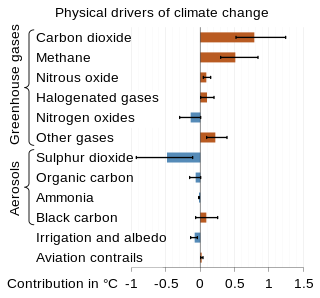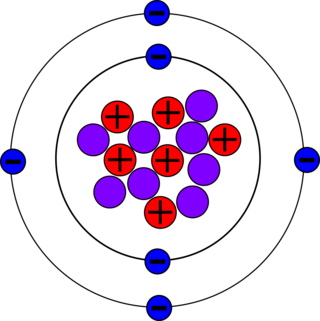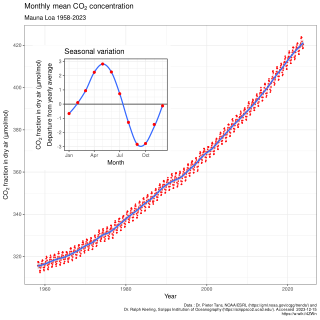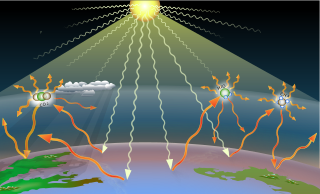Related Research Articles

The scientific community has been investigating the causes of climate change for decades. After thousands of studies, it came to a consensus, where it is "unequivocal that human influence has warmed the atmosphere, ocean and land since pre-industrial times." This consensus is supported by around 200 scientific organizations worldwide, The dominant role in this climate change has been played by the direct emissions of carbon dioxide from the burning of fossil fuels. Indirect CO2 emissions from land use change, and the emissions of methane, nitrous oxide and other greenhouse gases play major supporting roles.

Carbon-14, C-14, 14C or radiocarbon, is a radioactive isotope of carbon with an atomic nucleus containing 6 protons and 8 neutrons. Its presence in organic matter is the basis of the radiocarbon dating method pioneered by Willard Libby and colleagues (1949) to date archaeological, geological and hydrogeological samples. Carbon-14 was discovered on February 27, 1940, by Martin Kamen and Sam Ruben at the University of California Radiation Laboratory in Berkeley, California. Its existence had been suggested by Franz Kurie in 1934.

Scripps Institution of Oceanography (SIO) is the center for oceanography and Earth science at the University of California, San Diego. Its main campus is located in La Jolla, with additional facilities in Point Loma.

The Keeling Curve is a graph of the accumulation of carbon dioxide in the Earth's atmosphere based on continuous measurements taken at the Mauna Loa Observatory on the island of Hawaii from 1958 to the present day. The curve is named for the scientist Charles David Keeling, who started the monitoring program and supervised it until his death in 2005.

Charles David Keeling was an American scientist whose recording of carbon dioxide at the Mauna Loa Observatory confirmed Svante Arrhenius's proposition (1896) of the possibility of anthropogenic contribution to the greenhouse effect and global warming, by documenting the steadily rising carbon dioxide levels. The Keeling Curve measures the progressive buildup of carbon dioxide, a greenhouse gas, in the atmosphere.

Roger Randall Dougan Revelle was a scientist and scholar who was instrumental in the formative years of the University of California, San Diego and was among the early scientists to study anthropogenic global warming, as well as the movement of Earth's tectonic plates. UC San Diego's first college is named Revelle College in his honor.

Greenhouse gas (GHG) emissions from human activities intensify the greenhouse effect. This contributes to climate change. Carbon dioxide, from burning fossil fuels such as coal, oil, and natural gas, is one of the most important factors in causing climate change. The largest emitters are China followed by the United States. The United States has higher emissions per capita. The main producers fueling the emissions globally are large oil and gas companies. Emissions from human activities have increased atmospheric carbon dioxide by about 50% over pre-industrial levels. The growing levels of emissions have varied, but have been consistent among all greenhouse gases. Emissions in the 2010s averaged 56 billion tons a year, higher than any decade before. Total cumulative emissions from 1870 to 2022 were 703 GtC, of which 484±20 GtC from fossil fuels and industry, and 219±60 GtC from land use change. Land-use change, such as deforestation, caused about 31% of cumulative emissions over 1870–2022, coal 32%, oil 24%, and gas 10%.

In Earth's atmosphere, carbon dioxide is a trace gas that plays an integral part in the greenhouse effect, carbon cycle, photosynthesis and oceanic carbon cycle. It is one of three main greenhouse gases in the atmosphere of Earth. The concentration of carbon dioxide in the atmosphere reached 427 ppm (0.04%) in 2024. This is an increase of 50% since the start of the Industrial Revolution, up from 280 ppm during the 10,000 years prior to the mid-18th century. The increase is due to human activity.

The Global Carbon Project (GCP) is an organisation that seeks to quantify global greenhouse gas emissions and their causes. Established in 2001, its projects include global budgets for three dominant greenhouse gases—carbon dioxide, methane, and nitrous oxide —and complementary efforts in urban, regional, cumulative, and negative emissions.
The Suess effect is a change in the ratio of the atmospheric concentrations of heavy isotopes of carbon (13C and 14C) by the admixture of large amounts of fossil-fuel derived CO2, which contains no 14CO2 and is depleted in 13CO2 relative to CO2 in the atmosphere and carbon in the upper ocean and the terrestrial biosphere. It was discovered by and is named for the Austrian chemist Hans Suess, who noted the influence of this effect on the accuracy of radiocarbon dating. More recently, the Suess effect has been used in studies of climate change. The term originally referred only to dilution of atmospheric 14CO2 relative to 12CO2. The concept was later extended to dilution of 13CO2 and to other reservoirs of carbon such as the oceans and soils, again relative to 12C.

Greenhouse gases (GHGs) are the gases in the atmosphere that raise the surface temperature of planets such as the Earth. What distinguishes them from other gases is that they absorb the wavelengths of radiation that a planet emits, resulting in the greenhouse effect. The Earth is warmed by sunlight, causing its surface to radiate heat, which is then mostly absorbed by greenhouse gases. Without greenhouse gases in the atmosphere, the average temperature of Earth's surface would be about −18 °C (0 °F), rather than the present average of 15 °C (59 °F).

The atmospheric carbon cycle accounts for the exchange of gaseous carbon compounds, primarily carbon dioxide, between Earth's atmosphere, the oceans, and the terrestrial biosphere. It is one of the faster components of the planet's overall carbon cycle, supporting the exchange of more than 200 billion tons of carbon in and out of the atmosphere throughout the course of each year. Atmospheric concentrations of CO2 remain stable over longer timescales only when there exists a balance between these two flows. Methane, Carbon monoxide (CO), and other human-made compounds are present in smaller concentrations and are also part of the atmospheric carbon cycle.
Ralph Franklin Keeling is a professor at Scripps Institution of Oceanography. He is the Principal Investigator for the Atmospheric Oxygen Research Group at Scripps and is the director of the Scripps CO2 Program, the measurement program behind the Keeling curve, which was started by his father Charles David Keeling in 1958. Ralph Keeling has developed precise instruments and techniques for the measurement of atmospheric oxygen and anthropogenic CO2 in the ocean, and for the analysis of land and ocean carbon sinks.
Lisa Welp is a biogeochemist who utilizes stable isotopes to understand how water and carbon dioxide are exchanged between the land and atmosphere. She is a professor at Purdue University in the department of Earth, Atmosphere, and Planetary Sciences.
Gretchen Keppel-Aleks is an American scientist and assistant professor at the University of Michigan in the College of Engineering's department of Climate and Space Sciences and Engineering. She primarily focuses on Earth's climate and the effects of greenhouse gasses on Earth's atmosphere. Keppel-Aleks has been named a Kavli Fellow by the U.S. National Academy of Sciences.
Jill L. Bubier is a professor emerita of environmental science at Mount Holyoke College (MHC). Her research examines how Northern ecosystems respond to climate change.
Ingeborg Levin was a German professor in Geosciences at the Institute for Environmental Physics (IUP) of Heidelberg University. Her work with atmospheric measurements significantly contributed to the knowledge of greenhouse gas dynamics. She set up a global network that measures radiocarbon in carbon dioxide, information that can be used to verify bottom-up estimates of CO2 emissions. She uses the concentration data of several chemical species to constrain carbon emissions and help validate global atmospheric models.
References
- ↑ "One Hundred and Seventh Annual Commencement, June 15, 2001" (PDF). caltechcampuspubs.library.caltech.edu. Retrieved 2018-03-15.
- ↑ "The California Tech" (PDF). caltechcampuspubs.library.caltech.edu. 2001-05-11. Retrieved 2018-03-15.
- ↑ "Advancing the use of radiocarbon in studies of global and regional carbon cycling with high precision measurements of 14C in CO2 from the Scripps CO2 Program" (PDF). Retrieved 2018-03-15.
- ↑ "Atmospheric Oxygen Research Group - Publications". bluemoon.ucsd.edu. Retrieved 2018-03-15.
- ↑ Imperial College London (2017-12-11), Greenhouse gas study at Imperial , retrieved 2018-03-15
- ↑ "Former Members". www.up.ethz.ch. Retrieved 2018-03-15.
- ↑ "Seasonal CO2 Amplitude is Growing as More is Added to the Atmosphere | Scripps Institution of Oceanography, UC San Diego". scripps.ucsd.edu. Archived from the original on 2018-11-30. Retrieved 2018-03-15.
- ↑ "Carbon Cycle Research at Imperial College London". www.sp.ph.ic.ac.uk. Retrieved 2018-03-15.
- 1 2 "Carbon Cycle Research at Imperial College London". www.sp.ph.ic.ac.uk. Retrieved 2018-03-15.
- ↑ McGrath, Matt (2015-07-21). "Fossil fuels to hamper carbon dating". BBC News. Retrieved 2018-03-15.
- ↑ "The global carbon cycle in a changing climate". knowitwall.com. Retrieved 2018-03-15.
- ↑ "North American Carbon Program". www.nacarbon.org. Retrieved 2018-03-15.
- ↑ "CMS - the NASA Carbon Monitoring System". carbon.nasa.gov. Retrieved 2018-03-15.
- ↑ "Global Climate Science Imperatives in a Post-Paris Agreement World". AAAS - The World's Largest General Scientific Society. 2017-03-08. Retrieved 2018-03-15.
- ↑ "Why the Paris Agreement on climate change could be in trouble". iNews. 2017-08-08. Retrieved 2018-03-15.
- ↑ Stone, Maddie. "Why Solving Murders Is Going to Get a Lot Harder". Gizmodo. Retrieved 2018-03-15.
- ↑ Meteorologist, Brandon Miller, CNN Senior. "February shatters global heat records". CNN. Retrieved 2018-03-15.
{{cite news}}:|first=has generic name (help)CS1 maint: multiple names: authors list (link) - ↑ "Emissions threaten age of uncertainty for carbon dating - Climate News Network". Climate News Network. 2015-07-24. Retrieved 2018-03-15.
- ↑ Panko, Ben. "Thanks to Fossil Fuels, Carbon Dating Is in Jeopardy. One Scientist May Have an Easy Fix". Smithsonian. Retrieved 2018-03-15.
- ↑ LaFrance, Adrienne. "Global Warming Could Ruin Carbon Dating". The Atlantic. Retrieved 2018-03-15.
- ↑ "Swinging CO2 Levels Show The Earth Is 'Breathing' More Deeply". NPR.org. Retrieved 2018-03-15.